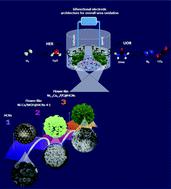Our official English website, www.x-mol.net, welcomes your
feedback! (Note: you will need to create a separate account there.)
3D ternary NixCo2-xP/C nanoflower/nanourchin arrays grown on HCNs: a highly efficient bi-functional electrocatalyst for boosting hydrogen production via the urea electro-oxidation reaction.
Nanoscale ( IF 5.8 ) Pub Date : 2020-07-10 , DOI: 10.1039/d0nr04616g Sharifeh Rezaee 1 , Saeed Shahrokhian
Nanoscale ( IF 5.8 ) Pub Date : 2020-07-10 , DOI: 10.1039/d0nr04616g Sharifeh Rezaee 1 , Saeed Shahrokhian
Affiliation

|
Over the last few years, substantial efforts have been made to develop earth-abundant bi-functional catalysts for urea oxidation and energy-saving electrolytic hydrogen production due to their low cost and the potential to replace traditional noble-metal-based catalysts. Nevertheless, finding a straightforward and effective route to prepare efficient catalysts with unique structural features and optimal supports still is a big challenge. Among the various candidates, metal–organic framework (MOF)-derived materials show great advantages as new kinds of active non-precious catalysts. On the other hand, the controllable integration of MOFs and carbon-based nanomaterials leads to further enhancement in terms of the stability and electrical conductivity of catalysts. In this communication, we develop an MOF-carbon-based composite to synthesize a transition metal phosphide (TMP) catalyst for the electrocatalytic oxidation of urea. First, poly(pyrrole-co-aniline) (PPCA) hollow nanospheres were fabricated via the in situ emulsion polymerization of a mixture of aniline and pyrrole in the presence of Triton X-100. Then, the simple carbonization treatment of these PPCA hollow spheres led to the carbonized hollow carbon nanospheres (HCNs) with ultrahigh surface areas and uniform nano-morphologies. After that, bimetallic MM′/MOFs (M/M′ = Ni, Co) were uniformly grown around the HCNs via a simple hydrothermal reaction (NiCo/MOF@HCNs). During the synthesis process, by adjusting Ni/Co ratios, the MOF morphology can be engineered so that by reducing the Ni/Co ratio, the flower-like structures change into urchin-like structures. Finally, this NiCo/MOF@HCNs precursor with different Ni/Co ratios during the in situ carbonization/phosphorization was chemically converted into Ni–Co mixed-metal phosphides (NixCo2−xP/C@HCNs). Finally, the electrocatalytic activity of the prepared catalysts was tested for the urea oxidation reaction (UOR) and hydrogen evolution reaction (HER).
中文翻译:

在HCN上生长的3D三元NixCo2-xP / C纳米花/ nanourchin阵列:一种高效的双功能电催化剂,可通过尿素电氧化反应提高产氢量。
在过去的几年中,由于其低成本和可替代传统的贵金属基催化剂的潜力,已为开发用于尿素氧化和节能的电解氢生产的富含地球的双功能催化剂做出了巨大的努力。然而,寻找一种简单有效的方法来制备具有独特结构特征和最佳载体的高效催化剂仍然是一个巨大的挑战。在各种候选物中,金属有机骨架(MOF)衍生的材料作为新型活性非贵金属催化剂显示出巨大的优势。另一方面,MOF和碳基纳米材料的可控整合导致催化剂稳定性和电导率的进一步提高。在这次交流中,我们开发了基于MOF碳的复合材料,以合成用于尿素电催化氧化的过渡金属磷化物(TMP)催化剂。首先,聚吡咯共-苯胺)(PPCA)中空纳米球被制造通过所述原位中的Triton X-100的存在下苯胺和吡咯的混合物的乳液聚合。然后,这些PPCA中空球的简单碳化处理导致碳化的中空碳纳米球(HCN)具有超高的表面积和均匀的纳米形态。之后,通过简单的水热反应(NiCo / MOF @ HCNs)在HCN周围均匀生长双金属MM'/ MOF(M / M'= Ni,Co )。在合成过程中,通过调整Ni / Co比例,可以设计MOF形态,从而通过降低Ni / Co比例,可以使花状结构变为野孩子状结构。最后,这种NiCo / MOF @ HCNs前体在制备过程中具有不同的Ni / Co比原位碳化/磷化被化学转化为Ni-Co混合金属磷化物(Ni x Co 2- x P / C @ HCNs)。最后,针对尿素氧化反应(UOR)和析氢反应(HER)测试了制备的催化剂的电催化活性。
更新日期:2020-08-06
中文翻译:

在HCN上生长的3D三元NixCo2-xP / C纳米花/ nanourchin阵列:一种高效的双功能电催化剂,可通过尿素电氧化反应提高产氢量。
在过去的几年中,由于其低成本和可替代传统的贵金属基催化剂的潜力,已为开发用于尿素氧化和节能的电解氢生产的富含地球的双功能催化剂做出了巨大的努力。然而,寻找一种简单有效的方法来制备具有独特结构特征和最佳载体的高效催化剂仍然是一个巨大的挑战。在各种候选物中,金属有机骨架(MOF)衍生的材料作为新型活性非贵金属催化剂显示出巨大的优势。另一方面,MOF和碳基纳米材料的可控整合导致催化剂稳定性和电导率的进一步提高。在这次交流中,我们开发了基于MOF碳的复合材料,以合成用于尿素电催化氧化的过渡金属磷化物(TMP)催化剂。首先,聚吡咯共-苯胺)(PPCA)中空纳米球被制造通过所述原位中的Triton X-100的存在下苯胺和吡咯的混合物的乳液聚合。然后,这些PPCA中空球的简单碳化处理导致碳化的中空碳纳米球(HCN)具有超高的表面积和均匀的纳米形态。之后,通过简单的水热反应(NiCo / MOF @ HCNs)在HCN周围均匀生长双金属MM'/ MOF(M / M'= Ni,Co )。在合成过程中,通过调整Ni / Co比例,可以设计MOF形态,从而通过降低Ni / Co比例,可以使花状结构变为野孩子状结构。最后,这种NiCo / MOF @ HCNs前体在制备过程中具有不同的Ni / Co比原位碳化/磷化被化学转化为Ni-Co混合金属磷化物(Ni x Co 2- x P / C @ HCNs)。最后,针对尿素氧化反应(UOR)和析氢反应(HER)测试了制备的催化剂的电催化活性。











































 京公网安备 11010802027423号
京公网安备 11010802027423号